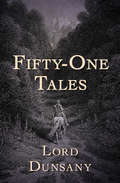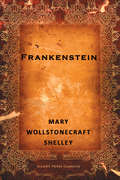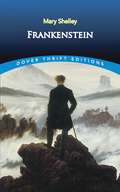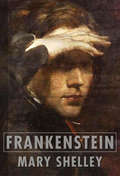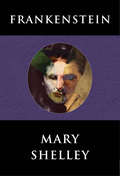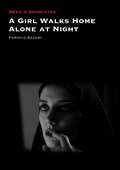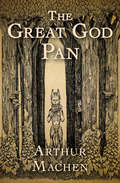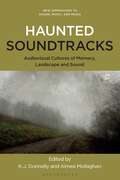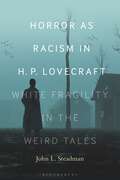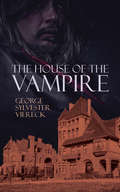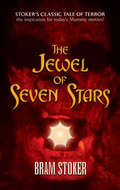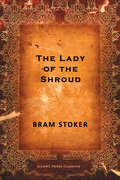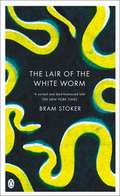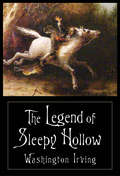- Table View
- List View
Fifty-One Tales
by Lord DunsanyA classic collection of short stories from one of the twentieth century’s most influential fantasy authors. Irish author Lord Dunsany majorly influenced generations of writers, including J. R. R. Tolkien, H. P. Lovecraft, and many more, and his Fifty-One Tales, a collection of short stories first published in 1915, has delighted readers for more than a century. These vignettes—some no more than a few paragraphs long—offer brief glimpses into worlds of sparkling wit and imagination. By turns whimsical, satirical, and melancholic, this collection (also published under the title The Food of Death) touches on timeless themes and remains a wellspring of inspiration and pleasure. This ebook has been professionally proofread to ensure accuracy and readability on all devices. “[Dunsany’s] rich language, his cosmic point of view, his remote dream-world, and his exquisite sense of the fantastic all appeal to me more than anything else in modern literature.” —H. P. Lovecraft
Frankenstein
by Mary ShelleyThe eccentric Dr. Victor Frankenstein creates life from assembled body parts, only to realise his creature is an abomination. He casts the monster out, deeply regretting his work. When the monster, despondent at his creator's disgust, attempts to befriend humans, he is rejected – a rejection that leads to violence and great loss for Frankenstein. A thematic indictment of blind ambition and man's fear of the unknown, Frankenstein endures as a classic piece of English literature and the inspiration for countless film and television adaptations.
Frankenstein: Or the Modern Prometheus (Dover Thrift Editions)
by Mary ShelleyFew creatures of horror have seized readers' imaginations and held them for so long as the anguished monster of Mary Shelley's Frankenstein. The story of Victor Frankenstein's terrible creation and the havoc it caused has enthralled generations of readers and inspired countless writers of horror and suspense. Considering the novel's enduring success, it is remarkable that it began merely as a whim of Lord Byron's."We will each write a story," Byron announced to his next-door neighbors, Mary Wollstonecraft Godwin and her lover Percy Bysshe Shelley. The friends were summering on the shores of Lake Geneva in Switzerland in 1816, Shelley still unknown as a poet and Byron writing the third canto of Childe Harold. When continued rains kept them confined indoors, all agreed to Byron's proposal.The illustrious poets failed to complete their ghost stories, but Mary Shelley rose supremely to the challenge. With Frankenstein, she succeeded admirably in the task she set for herself: to create a story that, in her own words, "would speak to the mysterious fears of our nature and awaken thrilling horror — one to make the reader dread to look round, to curdle the blood, and quicken the beatings of the heart."
Frankenstein, or The Modern Prometheus
by Mary ShelleyFrankenstein, or The Modern Prometheus is a novel written by English author Mary Shelley (1797–1851) that tells the story of Victor Frankenstein, a young scientist who creates a grotesque but sapient creature in an unorthodox scientific experiment. His monster has become one of the most recognized characters in all of literature.
Frankenstein, or The Modern Prometheus
by Mary ShelleyFrankenstein, or The Modern Prometheus is a novel written by English author Mary Shelley (1797–1851) that tells the story of Victor Frankenstein, a young scientist who creates a grotesque but sapient creature in an unorthodox scientific experiment. His monster has become one of the most recognized characters in all of literature.
Frankenstein, or the Modern Prometheus
by Mary Wollstonecraft ShelleyClassic horror story. Victor Frankenstein is obsessed with creating life. His botched creature sets out to destroy Frankenstein, and all he holds dear.
A Girl Walks Home Alone at Night (Devil's Advocates)
by Farshid KazemiThere is something weird and eerie going on in the oneiric Iranian ghost-town Bad City. A mysterious female vampire, clad in a long-black veil, imbued with occult and erotic power, has newly arrived in town and is summarily dispensing with its unsavory characters. Through a chance encounter in a night of luminal darkness, an eternally dark romance begins – baptized in love’s blood. Shot in dazzling anamorphic black and white cinematography and accompanied with an intoxicating and mesmeric soundtrack, Ana Lily Amirpour’s debut feature film A Girl Walks Home Alone At Night (2014), was an instant popular and critical success. Dubbed ‘the first Iranian vampire western’ the genre-bending film is a pastiche of genres such as vampire cinema, gothic and horror films, spaghetti westerns, graphic novels, and Iranian cinema; yet the film stands as a new vampire fairy-tale with a unique style all its own. The first full-length study dedicated to the film since its release, this book in the Devil’s Advocate series provides a unique approach to the film situated within three theoretical coordinates: the vampire genre, psychoanalytic (film) theory and German Idealism.
The Great God Pan
by Arthur MachenA gothic masterpiece set in Victorian England: “One of the best horror stories ever written. Perhaps the best in the English language” (Stephen King). When Mr. Clarke agrees to visit his friend Dr. Raymond, he is dubious about the proceedings he is to witness. In pursuit of what Raymond calls “transcendental science,” the doctor intends to make a small incision in a woman’s brain, allowing her to see past the world of the senses to a reality beyond imagining—a realm where, Raymond says, one can see the great god Pan. Though the experiment is an apparent failure, it will not be Clarke’s last brush with the sinister beyond. Years later, Clarke hears of a woman named Helen Vaughan, who is said to be at the root of many mysterious and tragic events. From London to the Americas and back, a string of suicides and disappearances lay in the wake of this evil seductress, whom Clarke believes is not entirely of this world. Upon publication in 1890, Arthur Machen’s The Great God Pan was deemed controversial for its depictions of paganism and sexual depravity. It has since been recognized as a masterwork of gothic horror. This ebook has been professionally proofread to ensure accuracy and readability on all devices.
The Grief Doctor
by Jack Anderson'A superb debut, playing cleverly with the concepts of memory and loss' GUY MORPUSS, author of FIVE MINDS'Will stay with you long after the last page' ADAM HAMDYGenius. Maverick. Monster. 'A place free of judgement… for a life free of pain'Since his beloved wife died, Arthur has lost all hope. He doesn't care about his high-powered job, his increasingly distressed mother, his future... Even his therapist cannot help him with his grief. In desperation, his mother seeks out the only person who can: Dr Elizabeth Codelle. Controversial genius, Dr Codelle runs the world's most exclusive clinic. Eye-wateringly expensive, the clinic is located on a small private island and takes only one patient at a time - but it gets results. Codelle doesn't just treat her clients, she claims to entirely cure them. And she is insistent that Arthur must stay on the island until he is all better. Whatever that takes.A hugely original, clever and thought-provoking thriller about one woman's vision and just how far you might go to cure grief.
Haunted Soundtracks: Audiovisual Cultures of Memory, Landscape, and Sound (New Approaches to Sound, Music, and Media)
The turn of the millennium has heralded an outgrowth of culture that demonstrates an awareness of the ephemeral nature of history and the complexity underpinning the relationship between location and the past. This has been especially apparent in the shifting relationship between landscape, memory and sound in film, television and other media. The result is growing interest in soundtracks, as part of audiovisual culture, as well as an interest in the spectral aspects of culture more generally. This collection of essays focuses on audiovisual forms that foreground landscape, sound and memory. The scope of inquiry emphasises the ghostly qualities of a certain body of soundtracks, extending beyond merely the idea of 'scary films' or 'haunted houses.' Rather, the notion of sonic haunting is tied to ideas of trauma, anxiety or nostalgia associated with spatial and temporal dislocation in contemporary society. Touchstones for the approach are the concepts of psychogeography and hauntology, pervasive and established critical strategies that are interrogated and refined in relation to the reification of the spectral within the soundtracks under consideration here.
Horror as Racism in H. P. Lovecraft: White Fragility in the Weird Tales
by Dr. or Prof. John L. SteadmanProviding a new perspective on Lovecraft's life and work, Horror as Racism in H.P. Lovecraft focuses on the overlap between the writer's personal beliefs and the racist images and narratives in his speculative fiction. Building on recent debates about Lovecraft and drawing on the concept of "white fragility," John Steadman argues that the writer's fiction reflects his feelings of resentment and anger towards non-white persons and was used to advocate for his racist, xenophobic political beliefs – that western civilization was in decline and slavery was justifiable among "superior" civilizations. In making these claims, Lovecraft's tales pit humans against extra-terrestrial aliens, developing a terrifying, futuristic vision of the Earth as a plantation planet. The familiar image of Lovecraft as a reclusive, creative genius and mentor to young writer-friends is dismantled through close readings of his fiction and nonfiction – including correspondence, essays, and poetry – and examination of his early biography. This image is replaced by that of a cruel, callous, and, at times, psychotic man, a violently vitriolic racist and white supremacist who hated most of the non-white races. While some will dismiss the author outright and others will read his fiction but ignore the racism, Horror as Racism in H.P. Lovecraft takes a middle ground: acknowledging Lovecraft's personal history and heinous intentions, it helps readers navigate the author's disturbing biography while also getting a better sense of the stories, which remain significant within American science fiction.
The House of the Vampire
by George Sylvester Viereck"He felt the presence of the hand of Reginald Clark - unmistakably - groping in his brain as if searching for something that had still escaped him. He tried to move, to cry out, but his limbs were paralyzed. When, by a superhuman effort, he at last succeeded in shaking off the numbness that held him enchained, he awoke just in time to see a figure, that of a man, disappearing in the wall that separated Reginald's apartments from his room..."This vampire doesn't want the blood from your veins; he's after the ideas in your head. The hypnotic Reginald Clarke chooses his victims for their artistic abilities, charms them, and discards them after robbing them of their gifts. Originally published in 1907, this gothic novella was among the first stories of its type and remains a gripping tale of psychic vampirism.
I Walked With a Zombie (Devil's Advocates)
by Clive DawsonI Walked with a Zombie (1943), Val Lewton's second feature for RKO Radio Pictures, was described by critic Robin Wood as 'perhaps the most delicate poetic fantasy in the American Cinema.' Following immediately in the wake of the groundbreaking Cat People (1942), Zombie pioneered an even more radical narrative approach yet proved to be the critical and commercial equal of its predecessor, cementing the reputation of both Lewton and his director, Jacques Tourneur. Despite the lurid, studio-imposed title, I Walked with a Zombie is a subtle and ambiguous visual poem that advanced a daring condemnation of slavery and colonialism at a time when such themes were being actively suppressed by government censors. Clive Dawson charts the complex development and production of the project, essential to understanding the concerns of the filmmakers in the context of wartime Hollywood, then analyses the film in detail, referencing a broad range of academic studies of the audio-visual text and distilling new insight into its layers of meaning. Finally, he explores the film's reception, and the influence it exerted on the horror genre and beyond. Extensive primary research has uncovered a wealth of previously unpublished new material that solves many unanswered questions and dispels various myths about this utterly unique film.
IT Chapters One and Two (Devil's Advocates)
by Alissa BurgerDrawing on critical analysis of film, the horror genre, the Gothic, and Stephen King scholarship, this book considers Andy Muschietti’s IT Chapter One (2017) and IT Chapter Two (2019) on multiple levels: as film (both as individual films and through their interconnected narrative), as adaptation, and as a barometer of the horror film’s popularity among fans. Key points of consideration include the significance of the fictional town of Derry as a traditionally Gothic “bad place,” the role of 1980s nostalgia in these two films, the complex navigation of memory and trauma, gender representation, queer representation, and the return of the repressed. The terrifying figure of Pennywise the clown is central to this analysis, including consideration of performance, costuming, and significance within the larger landscape of the “scary clown” popular culture trope, and through comparison to Tim Curry’s iconic performance in Tommy Lee Wallace’s 1990 miniseries. This Devil's Advocate contextualizes Muschietti’s films within the larger landscape of King’s literary and popular culture influence, as well as the debate surrounding “elevated” horror and the “horror boom” of the late 2010s.
The Jewel of Seven Stars
by Bram StokerSomeone has seized the fabled Jewel of Seven Stars from the mummy's grip, and the ancient Egyptian queen Tera has risen from her tomb to take it back—at any cost! This thrilling tale of adventure and ritual magic recounts a supernatural struggle in which archeologists, grave robbers, and anyone else who attempts to possess the Jewel meet a mysterious, violent fate.Bram Stoker, the author of Dracula, wrote this enthralling novel of possession, reincarnation, and an ancient curse at the peak of the Victorian fascination with Egyptology. His spellbinding blend of Eastern lore and classic horror fiction formed the template for the plots of dozens of mummy movies. This edition features the original ending as it appeared in the 1903 publication, a gripping conclusion that was censored in subsequent printings and long unavailable.
The Lady of the Shroud
by Bram StokerThe Lady of the Shroud is a novel by Bram Stoker, published in 1909. The book is an epistolary novel, narrated in the first person via letters and diary extracts from various characters, but mainly Rupert. The initial sections, leading up to the reading of the uncle's will, told by other characters, suggest that Rupert is the black sheep of the family, and the conditions of having to live in the castle in the Blue Mountains for a year before he can permanently inherit the unexpectedly large million-pound estate suggest the uncle is somehow testing the heir. When an unexpected, mysterious women cloaked in a wet shroud appears, she changes Rupert's destiny forever.
The Lair of the White Worm
by Bram StokerAn ancient evil walks among them. When Adam Salton arrives at his grand-uncle's Derbyshire estate he quickly senses that a macabre and malevolent force is at work. In his attempts to uncover the grisly mystery he encounters the chilling Lady Arabella and the obsessive Edgar Caswall, each harbouring their own dark and dreadful desires. To his horror, Adam discovers that something hideous is living in the grounds of nearby Castra Regis, something that feeds on the flesh of humans. And so begins a terrifying quest to destroy the evil lurking in their midst . . .
The Legend of Sleepy Hollow
by Washington IrvingThe Legend of Sleepy Hollow, along with its companion piece, Rip Van Winkle is one of the best-known short stories to have come from America—though written while Irving was living abroad in England. Best enjoyed at Hallowe'en! The story is set in 1790 in the countryside around the Dutch settlement of Tarry Town (historical Tarrytown, New York), in a secluded glen called Sleepy Hollow. Sleepy Hollow is renowned for its ghosts and the haunting atmosphere that pervades the imaginations of its inhabitants and visitors. Some residents say this town was bewitched during the early days of the Dutch settlement. Other residents say an old Native American chief, the wizard of his tribe, held his powwows here before the country was discovered by Master Hendrick Hudson. The most infamous spectre in the Hollow is the Headless Horseman, said to be the ghost of a Hessian trooper that had his head shot off by a stray cannonball during "some nameless battle" of the American Revolutionary War, and who "rides forth to the scene of battle in nightly quest of his head".
